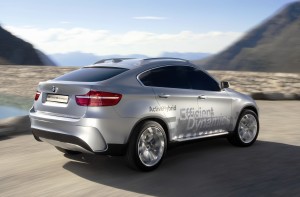
The proof of the press release boasting will come from test drives of production cars late this year.
If you take a four-door hatchback body style and combine it with the rear-drive hybrid drivetrain from General Motors that is also being used by Chrysler and Mercedes-Benz, can you come up with a BMW? Well, that’s what the German sports sedan maker is hoping to accomplish with the world debut of the X6 ActiveHybrid in New York.
The real uniqueness in BMW’s first hybrid due late this year appears, at first, to be the graphics that dominate the X6’s sculpted flanks. This gets at what remains the great issue of hybrid marketing. Thus far converted cars that do not have unique styling to proclaim their unique hybrid greenness have met with limited success in the marketplace. But perhaps that only applies to volume cars like the Toyota Prius?
Time will tell if the BMW approach of sliding a hybrid powertrain under existing body styles can work. And it must gall the Germans to be following Lexus – you know Japanese companies don’t innovate; they copy German engineering- the best selling luxury brand in the U.S., which has been selling hybrids for years now.
The proposition that BMW has been successfully selling is road dynamics. Here the company was at great pains to explain, on paper, that this hybrid will not only provide 20% better fuel economy than its gasoline fueled models, but it will perform like a BMW. Toward that end, it’s claimed that the powertrain consisting of an internal combustion engine, automatic transmission and two electric motors, along with the power electronics and the batteries, all combine to operate over a wider range of speeds than heretofore available in, you know, those other hybrids that are optimized for low-speed efficiency in city driving conditions.
The shared technology employed is certainly complex and expensive. The high-performance electric motors are attached to a transmission using fixed transmission ratios. These are connected to one another by three planetary gearsets, which allows a power split covering the output of the combustion engine and the electric motors in two transmission ranges – hence dual mode. BMW claims this allows a level of variability “quite impossible on a conventional hybrid drivetrain.”
The two-mode active transmission is based on an electrical continuously variable transmission (ECVT). The two operating modes, one of which has been optimized for lowspeeds, the other for high speeds, are supplemented by fixed transmission ratios.
The BMW version of this hybrid system, like the others, can be driven on electric power only, on the combustion engine alone, or with a combination of both power units. Nothing unique in this. Depending on driving conditions, the electric motors may also be used for both accelerating and regenerative braking, in which case the brake forces created when coasting and when applying the brakes is converted to electricity that flows into the batteries to provide an increase in electric power when needed. Again, nothing new.
What, perhaps, will be new is the driving experience? It remains to be seen how much the production BMW hybrid weighs, how the powertrain is calibrated, how responsive it is and if the driving experience is unique.
